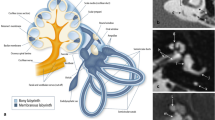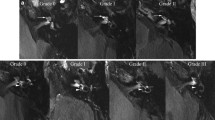Abstract
Objective
We compared the signal intensity ratio (SIR) of the cochlear basal turn between Meniere's disease and healthy controls to investigate potential damage of the blood–labyrinth barrier in Meniere's disease.
Methods
Thirty patients diagnosed with unilateral definite Meniere's disease and 24 healthy controls were enrolled. 3D-FLAIR scan was conducted to assess the grades of endolymphatic hydrops in Meniere's patients while measuring the SIR of cochlear basal turns in both groups. The differences of bilateral SIR between Meniere's disease and healthy control were compared, and the correlation between the SIR on affected ear in Meniere's disease and the grades of cochlear and vestibular hydrops were analyzed.
Results
SIR of affected ear in Meniere's disease exhibited significant increase compared to that of unaffected ear. No significant difference was observed in SIR between the two ears in the healthy control. Furthermore, the SIR of unaffected side in Meniere's disease was higher than that of both ears in healthy controls. The SIR in affected ear of Meniere's disease exhibited positive correlation with hydrops in both cochlea and vestibula.
Conclusion
The permeability of blood–labyrinth barrier is increased in Meniere's disease, in combination with the typical criteria of Meniere's disease it may be a good biological marker. Destruction of blood–labyrinth barrier may be one of the causes of endolymphatic hydrops in Meniere's disease.




Similar content being viewed by others
Data availability statement
All authors make sure that all data and materials as well as software application or custom code support their published claims and comply with field standards.
References
Nakashima T, Pyykko I, Arroll MA et al (2016) Meniere’s disease. Nat Rev Dis Primers 2(1):1–18
Hallpike CS, Cairns H (1938) Observations on the pathology of Menie`re’s syndrome. Proc R Soc Med 31(11):1317–1336
Merchant SN, Adams JC (2005) Pathophysiology of Ménière’s Syndrome: Are Symptoms Caused by Endolymphatic Hydrops? Otol Neurotol 25:74–81
Hegemann SCA (2021) Menière’s disease caused by CGRP—A new hypothesis explaining etiology and pathophysiology Redirecting Menière’s syndrome to Menière’s disease. J Vestibular Res 31(4):311–314
Zhang W, Xie J, Hui L et al (2021) The Correlation Between Endolymphatic Hydrops and blood-labyrinth barrier Permeability of Meniere Disease. Ann Otol Rhinol Laryngol 130(6):578–584
Tagaya M, Yamazaki M, Teranishi M et al (2011) Endolymphatic hydrops and blood-labyrinth barrier in Meniere’s disease. Acta Otolaryngol 131(5):474–479
Yang Y, Dai M, Wilson TM et al (2011) Na+/K+-ATPase alpha1 identified as an abundant protein in the blood-labyrinth barrier that plays an essential role in the barrier integrity. PLoS ONE 6(1):e16547
Ishiyama G, Wester J, Lopez IA et al (2018) Oxidative stress in the blood labyrinthine barrier in the macula utricle of meniere’s disease patients. Front Physiol 9:1–16
Dai M, Yang Y, Omelchenko I et al (2010) Bone marrow cell recruitment mediated by inducible nitric oxide synthase/stromal cell-derived factor-1alpha signaling repairs the acoustically damaged cochlear blood-labyrinth barrier. Am J Pathol 177(6):3089–3099
Naganawa S, Komada T, Fukatsu H et al (2006) Observation of contrast enhancement in the cochlear fluid space of healthy subjects using a 3D-FLAIR sequence at 3 Tesla. Eur Radiol 16(3):733–737
Naganawa S, Yamazaki M, Kawai H et al (2010) Visualization of Endolymphatic Hydrops in Máeni àere’s Disease with Single-dose Intravenous Gadolinium-based Contrast Media using Heavily T2-weighted 3D-FLAIR. Magn Reson Med Sci 9(4):237–242
Fiorino F, Pizzini FB, Beltramello A et al (2011) Reliability of Magnetic Resonance Imaging Performed After Intratympanic Administration of Gadolinium in the Identification of Endolymphatic Hydrops in Patients With Me´nie`re’s Disease. Otol Neurotol 32(3):472–477
Yamazaki M, Naganawa S, Kawai H et al (2012) Gadolinium distribution in cochlear perilymph: differences between intratympanic and intravenous gadolinium injection. Neuroradiology 54(10):1161–1169
Nakashima T, Naganawa S, Teranishi M (2010) Endolymphatic hydrops revealed by intravenous gadolinium injection in patients with Ménière’s disease. Acta Otolaryngol 130:338–343
Floc’h JL, Tan W, Telang RS et al (2014) Markers of cochlear inflammation using MRI. J Magn Reson Imaging 39(1):150–161
Naganawa S, Kawai H, Sone M et al (2010) Increased Sensitivity to Low Concentration Gadolinium Contrast by Optimized Heavily T2-weighted 3D-FLAIR to Visualize Endolymphatic Space. Magn Reson Med Sci 9(2):73–80
Tagaya M, Teranishi M, Naganawa S et al (2010) 3 Tesla magnetic resonance imaging obtained 4 hours after intravenous gadolinium injection in patients with sudden deafness. Acta Otolaryngol 130(6):665–669
Pakdaman MN, Ishiyama G, Ishiyama A et al (2016) Blood-Labyrinth Barrier Permeability in Meniere Disease and Idiopathic Sudden Sensorineural Hearing Loss: Findings on Delayed Postcontrast 3D-FLAIR MRI. AJNR Am J Neuroradiol 37(10):1903–1908
Barath K, Schuknecht B, Naldi AM et al (2014) Detection and grading of endolymphatic hydrops in Meniere disease using MR imaging. AJNR Am J Neuroradiol 35(7):1387–1392
Naganawa S, Kawai H, Taoka T et al (2016) Cochlear Lymph Fluid Signal Increase in Patients with Otosclerosis after Intravenous Administration of Gadodiamide. Magn Reson Med Sci 15(3):308–315
Yamazaki M, Naganawa S, Tagaya M et al (2011) Comparison of Contrast Effect on the Cochlear Perilymph after Intratympanic and Intravenous Gadolinium Injection. AJNR Am J Neuroradiol 33(4):773–778
Huppert D, Strupp M, Brandt T (2010) Long-term course of Meniere’s disease revisited. Acta Otolaryngol 130(6):644–651
Lopez-Escamez JA, Carey J, Chung WH et al (2015) Diagnostic criteria for Meniere’s disease. J Vestib Res 25(1):1–7
Shi S, Guo P, Wang W (2018) Magnetic Resonance Imaging of Meniere’s Disease After Intravenous Administration of Gadolinium. Ann Otol Rhinol Laryngol 127(11):777–782
Nyberg S, Abbott NJ, Shi X et al (2019) Delivery of therapeutics to the inner ear: The challenge of the blood-labyrinth barrier. Sci Transl Med 11(482):1–11
Sun W, Wang W (2015) Advances in research on labyrinth membranous barriers. J Otol 10(3):99–104
Berrettini S, Seccia V, Fortunato S et al (2013) Analysis of the 3-Dimensional Fluid-Attenuated Inversion-Recovery (3D-FLAIR) Sequence in Idiopathic Sudden Sensorineural Hearing Loss. JAMA Otolaryngol Head Neck Surg 139(5):456–464
Lee HY, Jung SY, Park MS et al (2012) Feasibility of three-dimensional fluid-attenuated inversion recovery magnetic resonance imaging as a prognostic factor in patients with sudden hearing loss. Eur Arch Otorhinolaryngol 269(8):1885–1891
Marshall AF, Jewells VL, Kranz P et al (2010) Magnetic resonance imaging of guinea pig cochlea after vasopressin-induced or surgically induced endolymphatic hydrops. Otolaryngol Head Neck Surg 142(2):260–265
Ishiyama G, Lopez IA, Sepahdari AR et al (2015) Meniere’s disease: histopathology, cytochemistry, and imaging. Ann NY Acad Sci 1343:49–57
Funding
No funding was received to assist with the preparation of this manuscript.
Author information
Authors and Affiliations
Contributions
All authors contributed to the study conception and design. Material preparation, data collection and analysis were performed by WZ and JX. The first draft of the manuscript was written by WZ and review and editing: MW and HL. All authors read and approved the final manuscript.
Corresponding author
Ethics declarations
Conflict of interest
The authors have no competing interests to declare that are relevant to the content of this article.
Ethical approval
This study was approved by the Medical Ethics Committee of Henan Provincial People's Hospital (2022-174).
Consent to participate
Informed consent was obtained from all individual participants included in the study.
Additional information
Publisher's Note
Springer Nature remains neutral with regard to jurisdictional claims in published maps and institutional affiliations.
Rights and permissions
Springer Nature or its licensor (e.g. a society or other partner) holds exclusive rights to this article under a publishing agreement with the author(s) or other rightsholder(s); author self-archiving of the accepted manuscript version of this article is solely governed by the terms of such publishing agreement and applicable law.
About this article
Cite this article
Zhang, W., Xie, J., Liu, H. et al. Blood–labyrinth barrier breakdown in Meniere’s disease. Eur Arch Otorhinolaryngol 281, 2327–2332 (2024). https://doi.org/10.1007/s00405-023-08353-7
Received:
Accepted:
Published:
Issue Date:
DOI: https://doi.org/10.1007/s00405-023-08353-7




